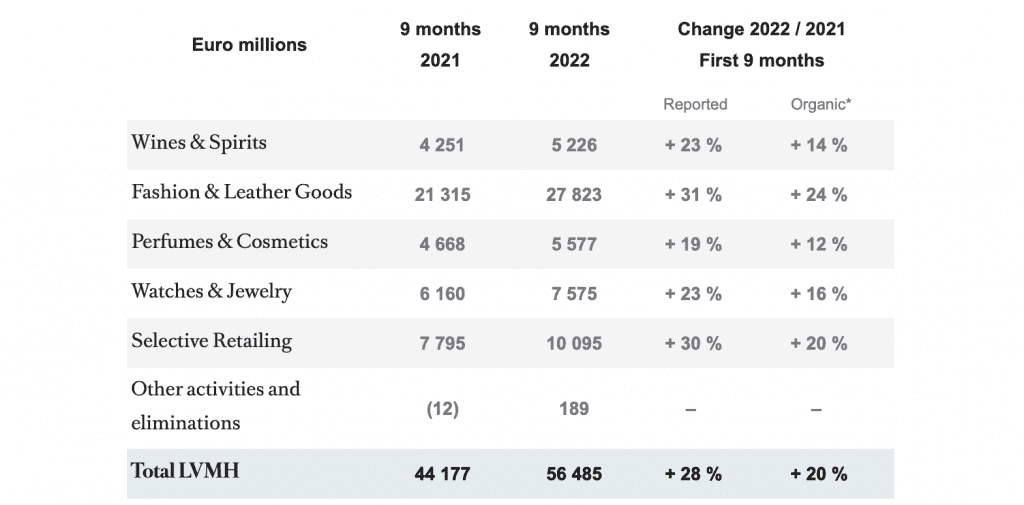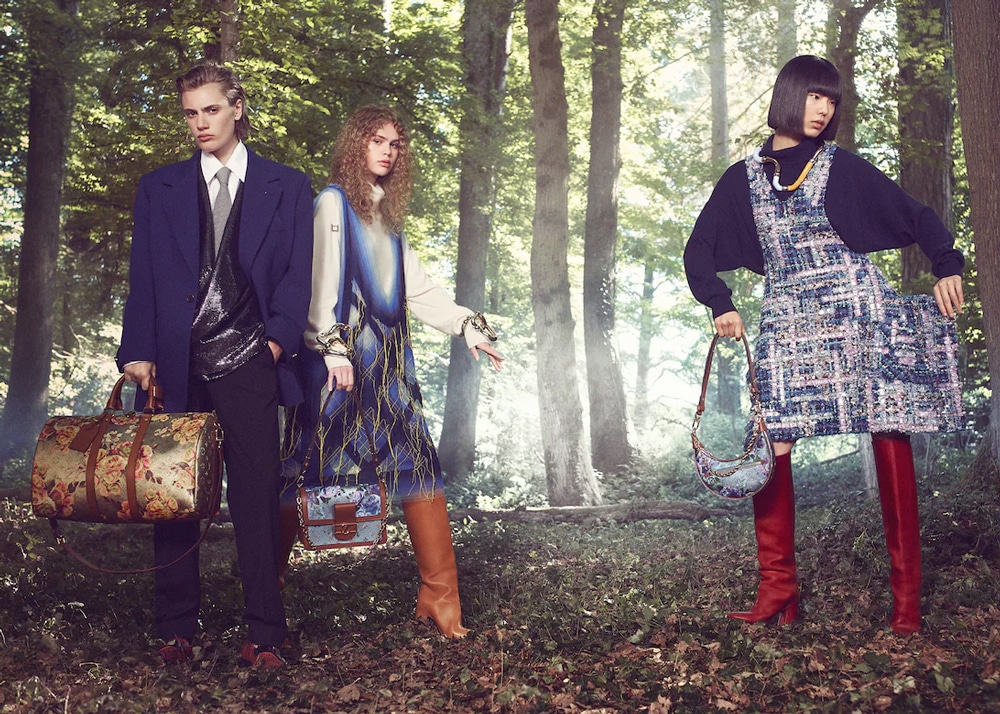LVMH Moët Hennessy Louis Vuitton recorded revenue of 56.5 billion euros ($55.1 billion) for the first nine months of 2022, up 28 percent compared to the same period of 2021. Revenue for the third-quarter (ending on September 30) totaled 19.8 billion euros ($19.2 billion), up 19 percent compared to Q3 2021. The luxury goods titan – which owns Louis Vuitton, Dior, Celine, and Givenchy, among an array of other brands – highlighted “sharp” sales increases in Europe, the United States, and Japan thanks to “solid demand of local customers,” as well as “the recovery in international travel,” and as usual, it pointed to the might of its Fashion & Leather Goods division, which generates almost 50 percent of its total revenue.
Delving into its biggest division, LVMH reported that revenue for the Fashion & Leather Goods business group grew by 31 percent in the first nine months of 2022 to 21.3 billion euros ($20.75 billion). LVMH pointed to Louis Vuitton, including the success of “many new products [which] were unveiled [over the past 9 months], in leather goods notably, as well as in watches.” The 200 Tambour Twenty collector’s watches, for instance, were “immediately out of stock” when they were released last month. The group’s second largest fashion brand Dior, which boasted slightly higher growth in Q3 than Louis Vuitton, has “continued to achieve remarkable growth in all its product lines,” per LVMH, which notes the “excellent performance of leather goods and ready-to-wear” and the “continued success of icons like Lady Dior.”

Meanwhile, “Celine saw very strong growth resulting from the success of Hedi Slimane’s creations,” namely, “strong progress of ready-to-wear” and “success of new high-end leather line for Triomphe and 16 models,” as did Loewe, where sales were driven by the good performance of leather goods lines Puzzle and Hammock,” according to LVMH. And still yet, “Loro Piana maintains good momentum” driven by the “great success” of its Resort collection; Marc Jacobs has shown “sustained growth of online sales,” as has been the message from LVMH in the past several quarters; and Rimowa saw “strong demand” again thanks to an increase in summer travel. (The mention of Givenchy was limited to its “continued store network expansion and renovation,” with still no mention of the success of (of lack thereof) Matthew Williams’ designs.)
In addition to Rimowa benefitting from a return to travel, LVMH’s Selective Retailing division, which houses duty-free retailer DFS, saw a big boost – up 30 percent for the first 9 months of the year. Sales activity for DFS is “still impacted by lockdowns in Hong Kong and Macao,” but it is also engaging in “progressive reopening in North America, Abu Dhabi, and Japan.” Also under the Selective retailing umbrella is Sephora, which “enjoyed excellent performance with a strong rebound in its in-store activity,” with momentum being “particularly strong in North America, France, and the Middle East.”
With revenue growth of 19 percent over the first 9 months of 2022, LVMH says that its Perfumes & Cosmetics business group maintained its “highly selective distribution strategy” and saw “strong momentum” for fragrances.
The Watches & Jewelry business group recorded revenue growth of 23 percent for the same period, thanks, in large part to, “excellent” performances of Tiffany and Bulgari, with the latter proving to be the stronger performer in Q3. In terms of Tiffany, sales are being driven by strong momentum in the U.S., LVMH states, as well as an array of “successful launches,” including the Lock bracelet in U.S., an international rollout of the Knot, and High Jewelry collection Blue Book in Asia. The group’s management said during an earnings call on Tuesday that it is “hopeful” the Lock collection, which appears to be Tiffany’s attempt to compete with Cartier’s Love bracelet, “could be sizable in the future.” Management also specifically pointed to watches as a key source of growth, noting that watches are “a well-suited category for an inflationary environment.” (Gold similarly performs well in an inflationary environment.)
Geographically speaking, the group’s 9-month sales were up in Europe and the U.S., while “Asia (including China) saw a lower level of growth over the first nine months of 2022, though growth in the latest quarter accelerated there due to the partial easing of health restrictions.” China, in particular, continues to see low foot traffic in stores compared to 2019, LVMH management said, noting that while the situation improved from 2Q, traffic to stores still is not back to normal. “Numbers in China were more or less flat for Louis Vuitton in 3Q,” Bernstein’s Luca Solca asserted in a note on Tuesday.
As for trends in consumption from a regional perspective, LVMH Chief Financial Officer Jean Jacques Guiony said that “in fashion and leather goods, part of the business has shifted away from the U.S. and towards Europe as U.S. citizens benefit from the strength of the dollar.” More broadly, LVMH management revealed that digital growth has been slowing down over past year, as business in most markets (excluding China) shifts back to brick-and-mortar.













